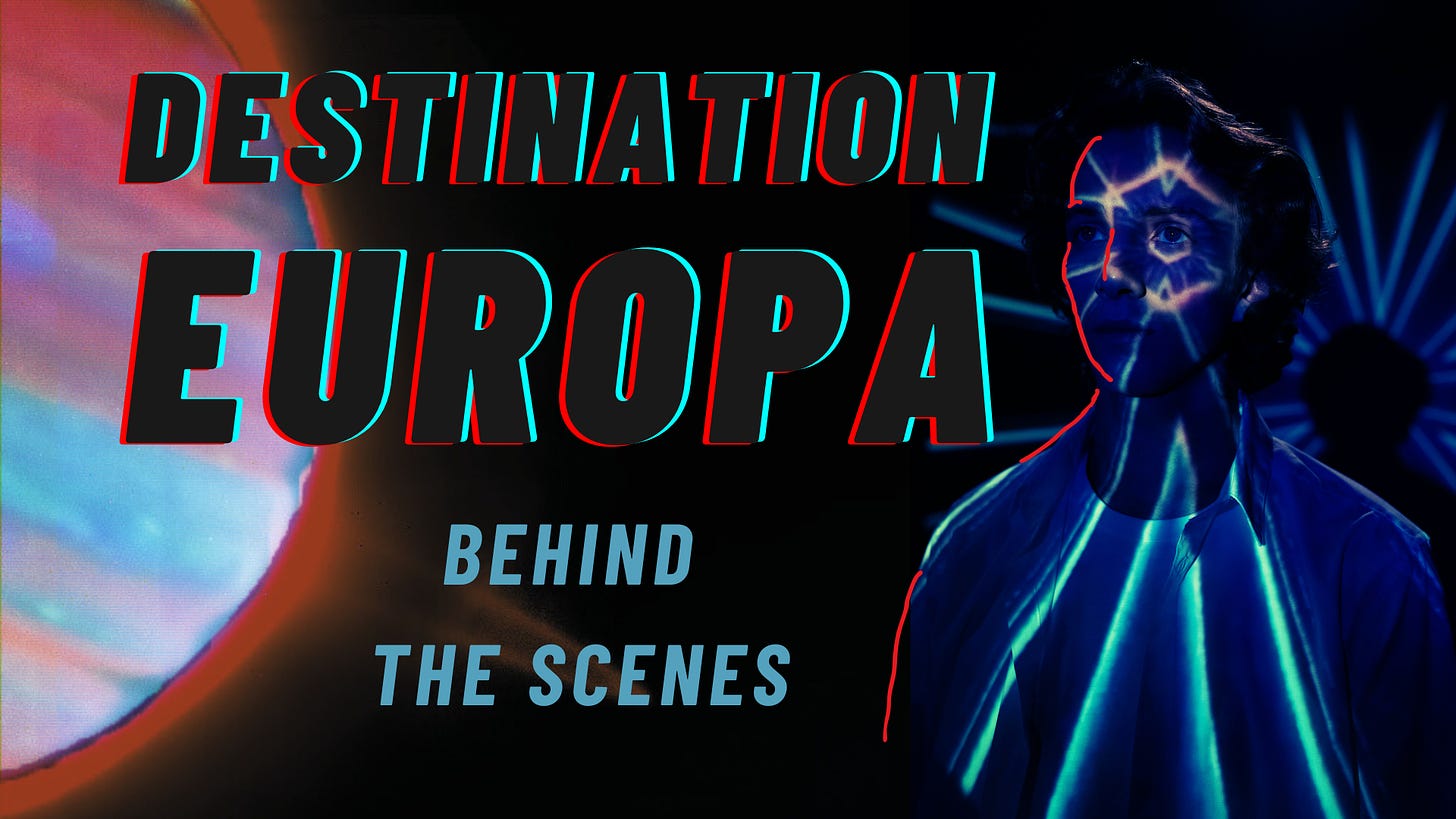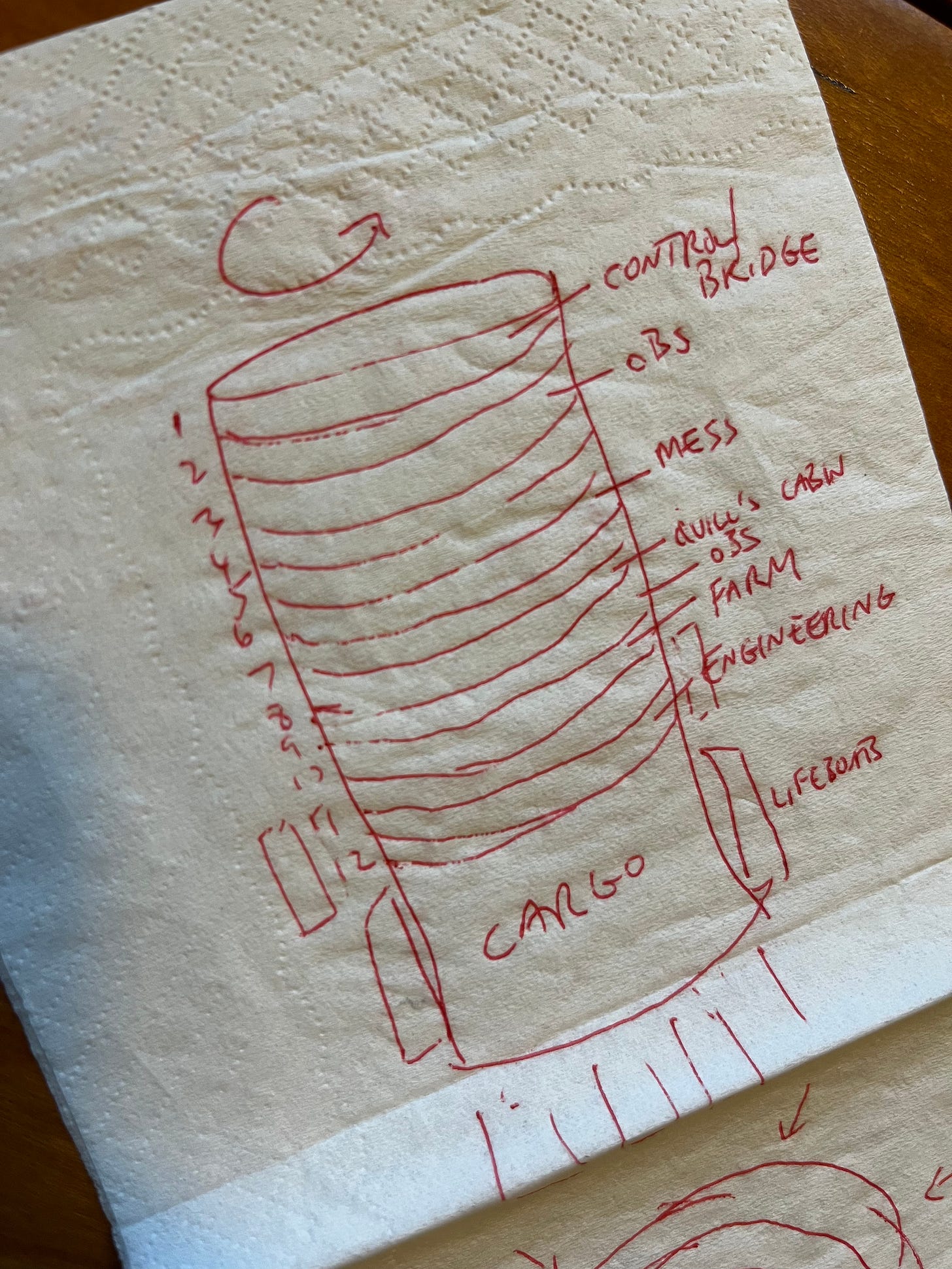Destination Europa: Behind the Scenes
The story behind the story (spoiler-free), and plans for what's next!
Destination Europa, my first online serial, has just wrapped up. I’m immensely proud, as well as a little bit sad. I’ve been walking with these characters — haunted, heartbroken Quill, down-to-earth Tark, up-to-something Safira — for so long that it feels strange to let them go. At least for now… stay tuned for what might come next!
The story began during November 2022. I was teaching at a university in China, which was still mired in draconian Covid restrictions. There were long stretches of time when I was unable to leave the city, and when life was narrowed down to my apartment, my office on campus, and the screen of my laptop. I had done NaNoWriMo (National Novel Writing Month) once before, during Covid lockdown in Scotland a couple of years earlier; this seemed like a good opportunity to try it again. The result was the first draft of a story I titled Mission Europa.
After that, it sat in the digital equivalent of a dusty drawer for a couple of years, while I did other things and wrote other stories. After launching my fiction newsletter and publishing a few short stories, I began to think about doing something a bit longer, in serial form. I had a few novel or novella-length manuscripts sitting around, all in draft form. Mission Europa was the shortest and the one I thought would work best for a first attempt at serialising. I dusted it off and began to think about how I might tackle it.
Reading the first draft for the first time since I’d written it, I thought the basic story would work. There were even parts that I thought weren’t bad. But there were issues with pacing, and then there were the bits where I’d just written “[more stuff happens]” and forgotten to go back and fill in the gaps. It became clear that rewriting and serialising it would take more work than I’d optimistically imagined. At the same time, I was excited about giving it a go.
I started by breaking the existing draft into scenes and plotting it out on a colour-coded pinboard (made using Padlet). From there I could visualise the overall flow of different threads in the story, and work out where I needed to move things up or where there were unnecessary dead-end threads that could just be cut. Then I plotted out a rough outline for the revised story using the Blake Snyder “Save the Cat” beat sheet method1, which I’d seen several other writers mention. The final version didn’t always follow that outline exactly, but it was helpful in keeping me on track week by week.
Before launching, there were a couple more decisions to make. One was the title. I dithered between Mission Europa and Destination Europa. I eventually settled on Destination, mainly because I didn’t want people thinking of Mission: Impossible. The other thing to decide was a “cover.” I had a lot of fun on Canva, messing about with different images, fonts and colours before settling on the design I finally used.
With a new outline, a title and a cover image, I announced a launch date of May 3rd. I reckoned there would be 20-something chapters. With one chapter a week, that would take me into September. I was also planning a move from China back to Scotland in August. On the face of it, running a weekly serial while wrapping up my job, apartment and life in one country and re-starting in another might not seem like ideal timing. But I decided that if I waited for the ideal time, it would never happen. And so I plunged in.
Initially, I tried to keep a buffer of four chapters or so. However, that evaporated very quickly, and I found myself racing each week to complete the next chapter. I wrote in our campus bar with my dear friend and writing partner there; I wrote in my apartment in the midst of packing boxes; I wrote on high-speed trains to Xi’an and Beijing; I wrote in the Peet’s Coffee near my friend’s apartment in Beijing; and then I was back home and writing in my old childhood bedroom, surrounded by the books that had formed my young imagination.
It was sometimes stressful. But an unexpected benefit was the thread of continuity that it gave in life when almost everything else was changing. I think it helped keep me sane, in a way. My non-fiction newsletter, Canal Town Teacher, rather went by the board during this period. I felt that there were things I should be writing about in the process of leaving China after sixteen years, but my head and heart couldn’t wrangle that into words on a page. A fictional story about stuff happening on a spaceship on the way to Jupiter, though — that, I could escape into.
The research was fun, too. Because I’d written the first draft in a month, pushing to get it done for the NaNo challenge, I’d not done a lot of detailed research at the time. For this version, I wanted as much scientific accuracy as possible. I went down lots of fascinating rabbit holes about the best frequencies of light for growing plants in space, or the experiments NASA did taking honeybees on the space shuttle. I also scraped the rust off what I’d learned long ago about angular momentum and centrifugal force and did some paper-and-pencil calculations for how fast the Leifr would have to rotate to give a reasonable level of artificial gravity and such (and realised how very much I have forgotten since undergraduate days!). I drew diagrams on a cafe napkin for how the ship’s rings and decks worked, and had to keep referring to them; I was always forgetting that the “down” direction was outward, perpendicular to the ship’s axis, and not aft along its length.
Other things, like the neural implants that allow people to connect to the ship’s AI and to enhance or modify their vision and hearing, I left more vague. It’s Advanced Future Tech that’s well beyond what we can do now, but how exactly it works isn’t necessary for the plot. I did reduce the capabilities of these neural chips somewhat compared to the first draft — originally, I had them augmenting the sense of smell too, but on reflection I thought that was probably more difficult to deal with than vision or hearing.
There were other changes. Very little of the text from the first draft survived into the published version. The plot was more or less the same, and I knew how it ended, but some plot points in the middle changed a bit. Some characters merged - Tark was originally two different people. New characters appeared. When I added bees to the ship, they called for a beekeeper and thus Olga the Apiarist showed up and worked herself into the story in a way I didn’t expect. I guess I’m very much a discovery writer, and for me, that’s all part of the fun.
Writing it as a serial meant that whenever a character was named or a detail added, it was fixed for the rest of the story. This actually felt remarkably freeing. There was no chance for second-guessing or renaming after a post went live. It did mean I had to pay more attention to each thread of the story and make sure I didn’t contradict any details from an earlier chapter, which sometimes meant trawling through the older chapters to double-check which deck the coffee cabin was on, or what I’d named the head cook. I should probably look into some manuscript handling software for future projects.
Now, all the document files are closed, as well as the multiple open browser tabs on travel times to Jupiter, the strange ice of Europa and so on. For a day or two after publishing the Epilogue, I took deep breaths of relief. But then I woke one morning thinking about what the cover of a paperback version might look like. I’ve not put pen (or paint) to paper for that yet, but after giving the serial version some time to breathe, I do intend to revise and publish it as a book, probably sometime in 2025. Until then, the full serial will remain available to read for free.
Publishing a serial has been challenging, but hugely enjoyable. It’s stretched me as a writer. It’s allowed me to interact with some wonderful readers, who’ve kept me going at times when I wondered if it was working, and that sense of community is one of the things that made it so enjoyable. I think I’ve caught the bug for it now. I’ve never run a marathon, but I think there are parallels: it’s hard work, sometimes you wonder why the heck you’re putting yourself through this, but there are glorious highs along the way and a real buzz at the end. I have a few ideas percolating for possible sequels. Watch this space!
If you’ve not read the story yet, it’s still available for free!
Cover image of Jupiter © National Astronomical Observatory of Japan, with colour modification by S.D.G. Lemaître.
I used this template, but there are lots out there.







it was indeed a wonderful adventure to be on and I find it amazing that this story was almost like a traveling companion to you as your went through big changes and you made your way literally across the world! I'm so glad you caught the serial bug because if you ask me, you're really good at it and I look forward as a reader to seeing what's next!
Also, a paperback copy 👀 you have my attention and funds when the time comes!
Thanks for posting this. It’s interesting to see the similarities between how we have approached our respective writing projects. I too wrote a draft and then decided to serialise it. I also tried to stay at least a month or so ahead but that evaporated to somewhere!
Although my project was never intended to be a serial, putting out the posts has been good motivation to keep pushing through and editing. What I wasn’t ready for was the feeling from “real” people actually reading my work. Although it’s only a relatively small number right now it’s incredibly gratifying.
I have found though having a busy day job it’s not healthy to spend all of your spare time on one project, there has to be a balance. Hence I have decided to also build in some breaks. I look forward to seeing what your next project will be.